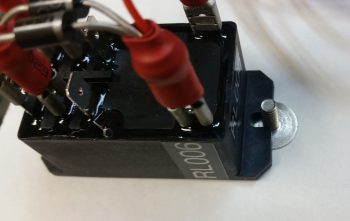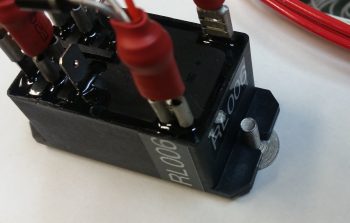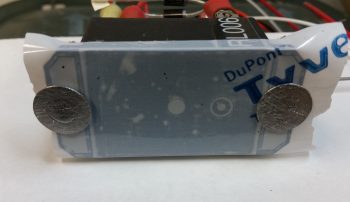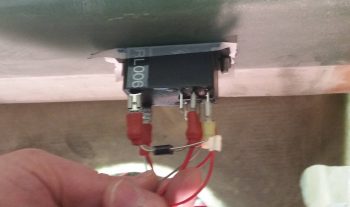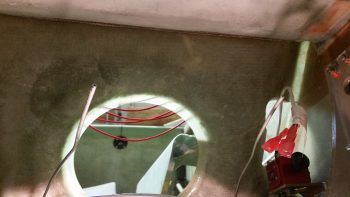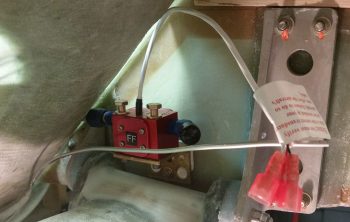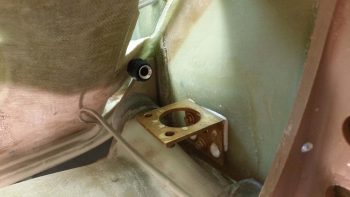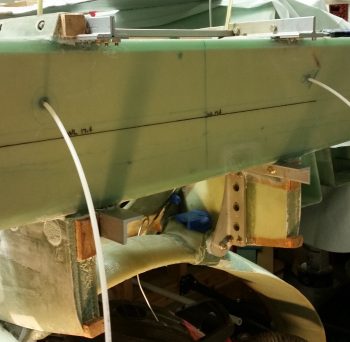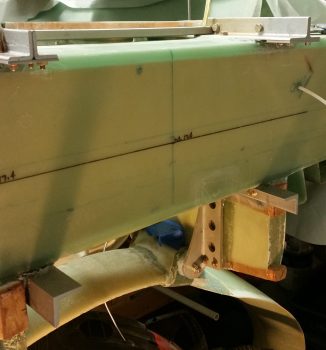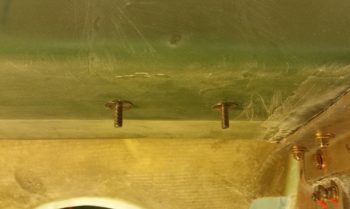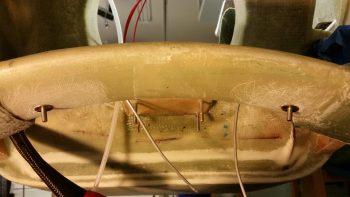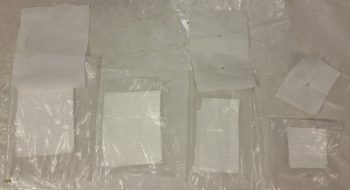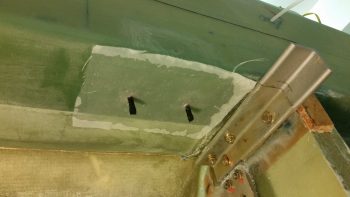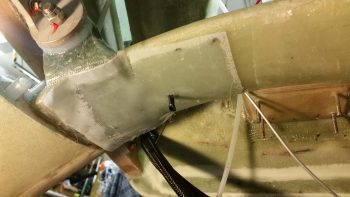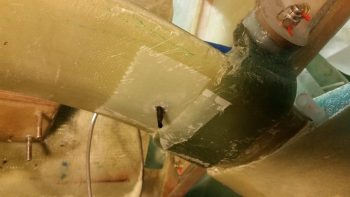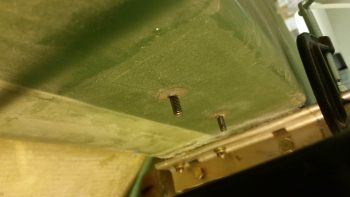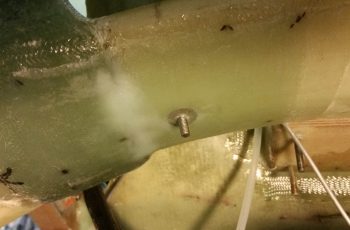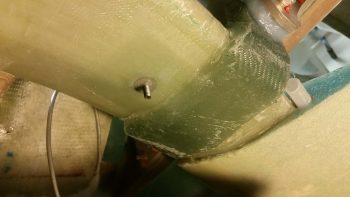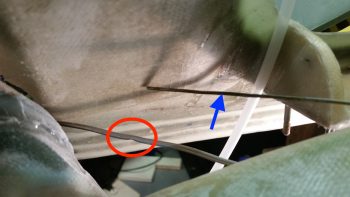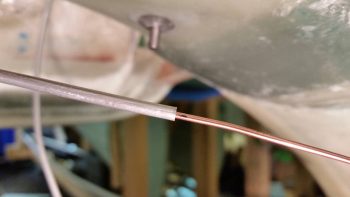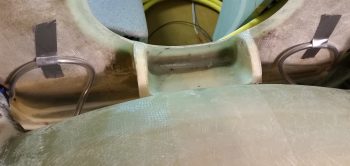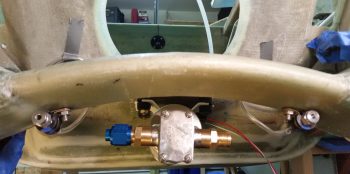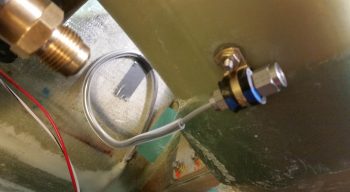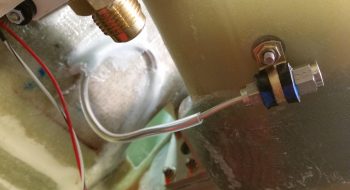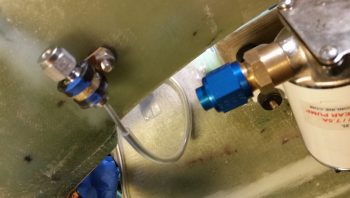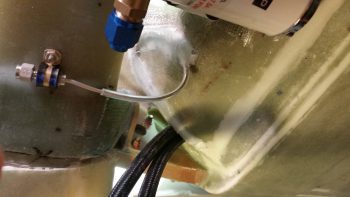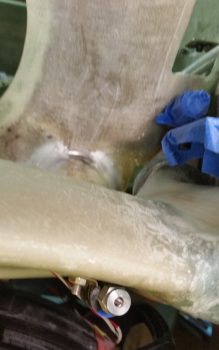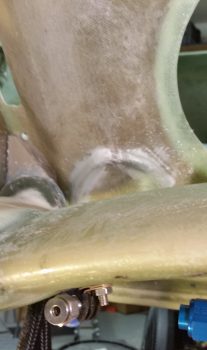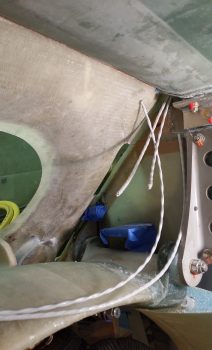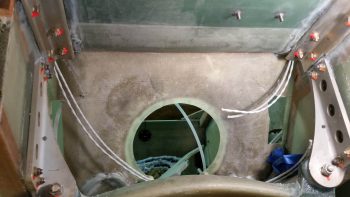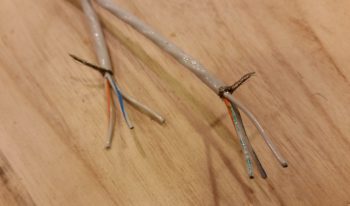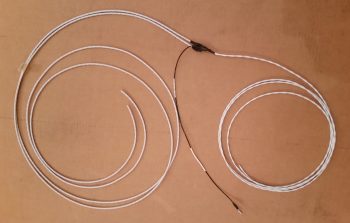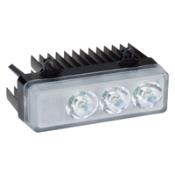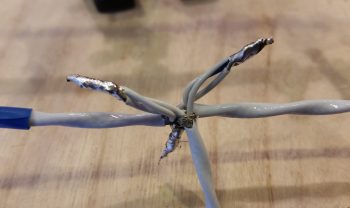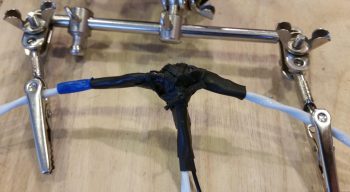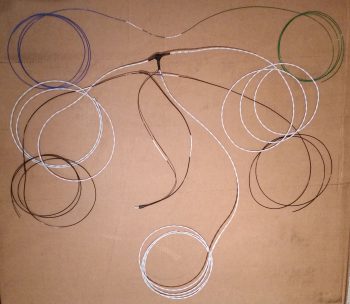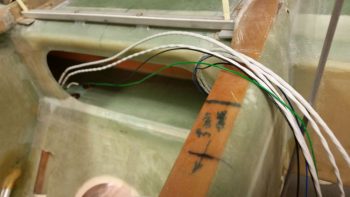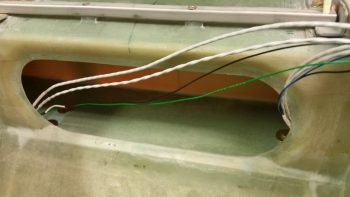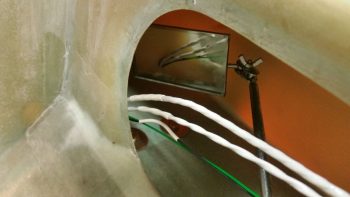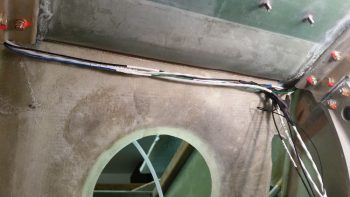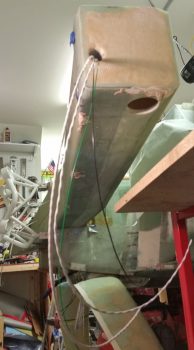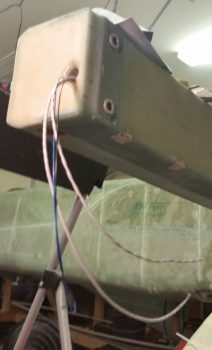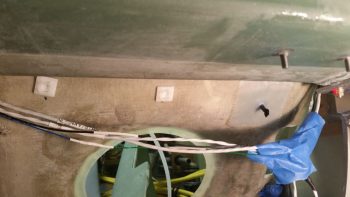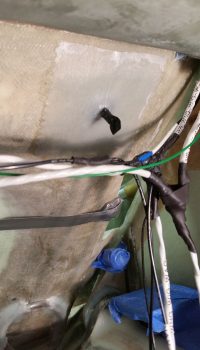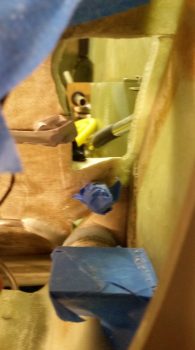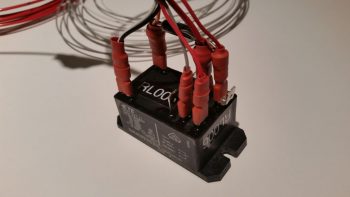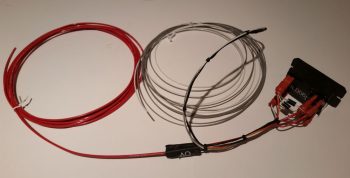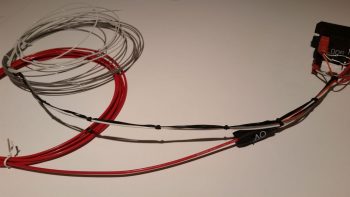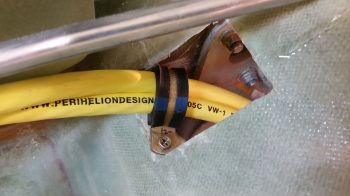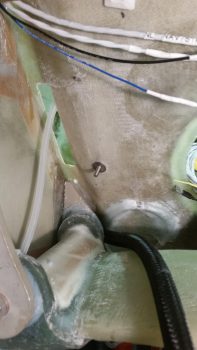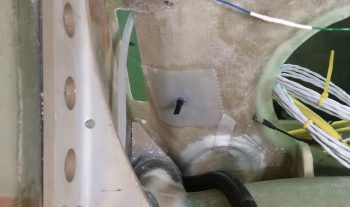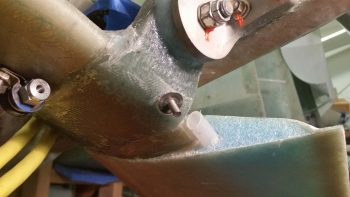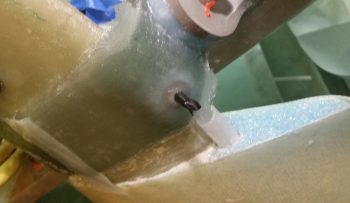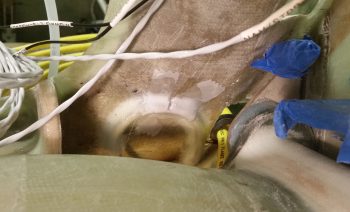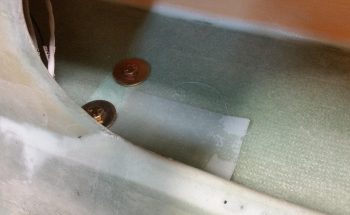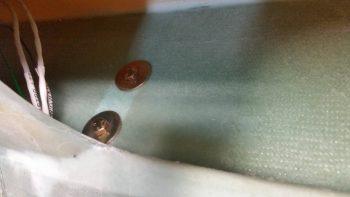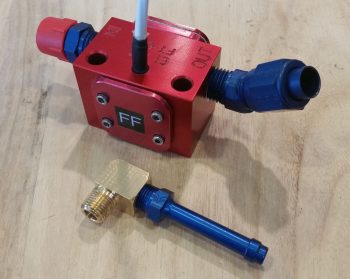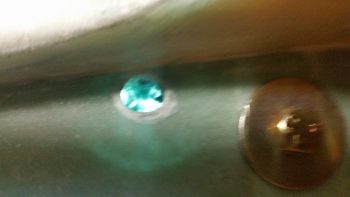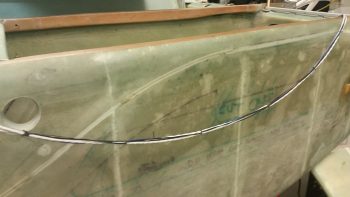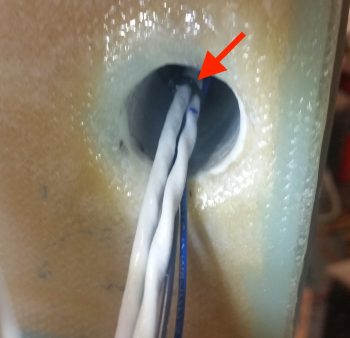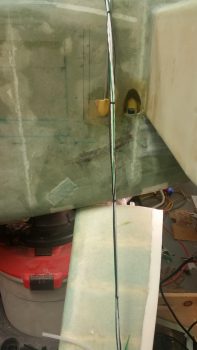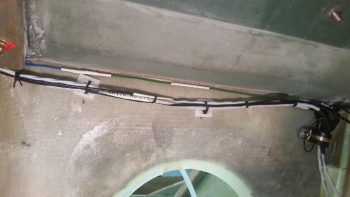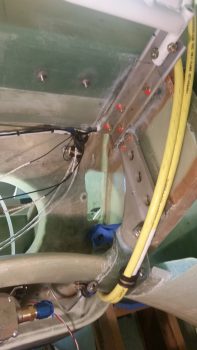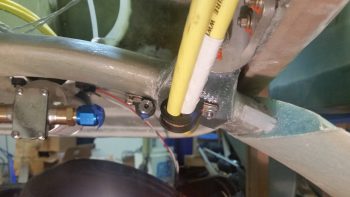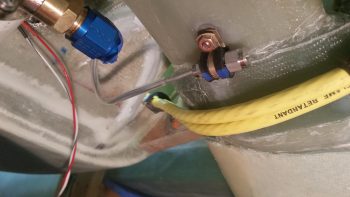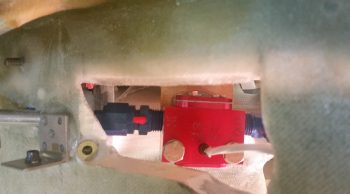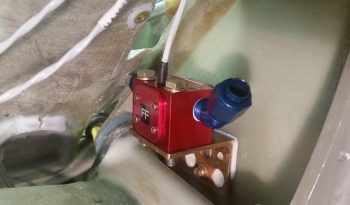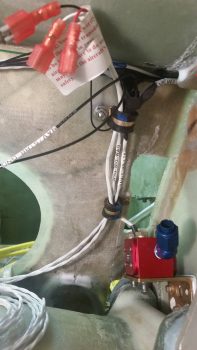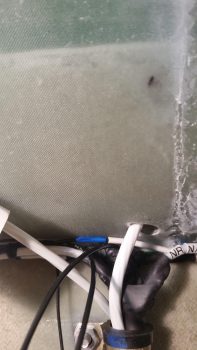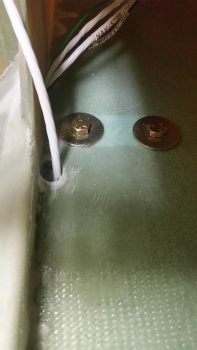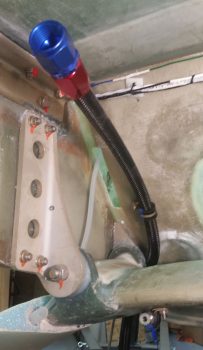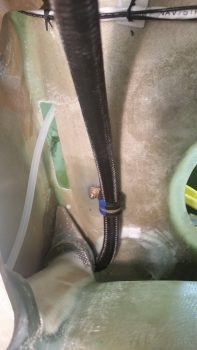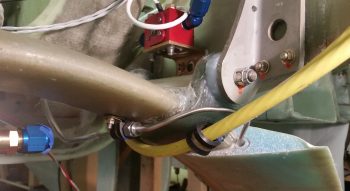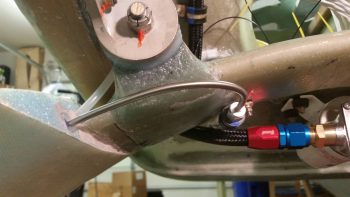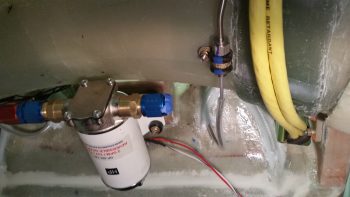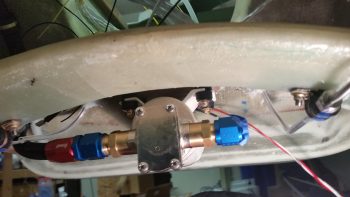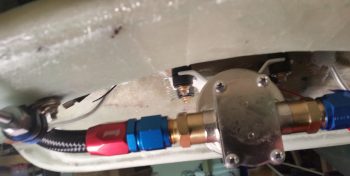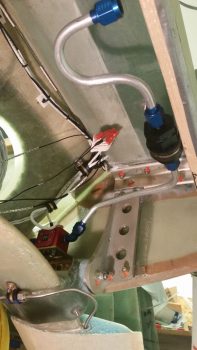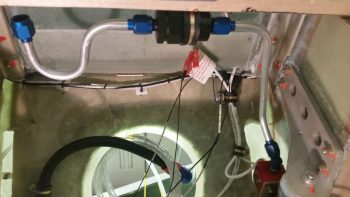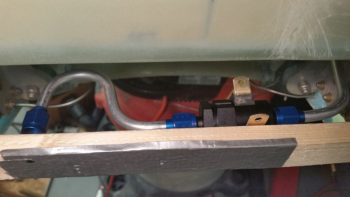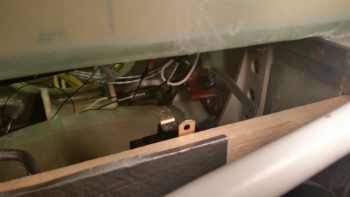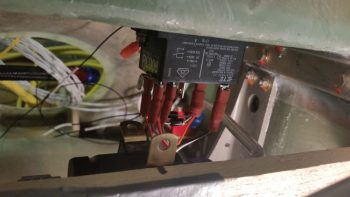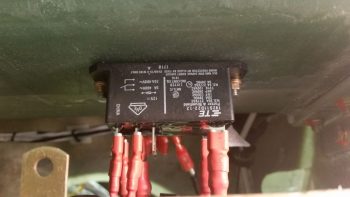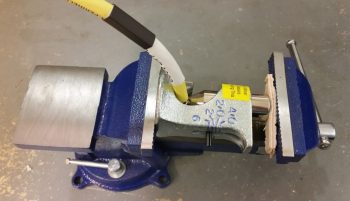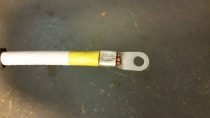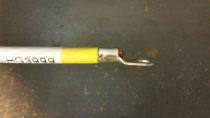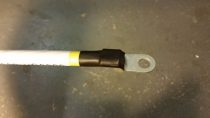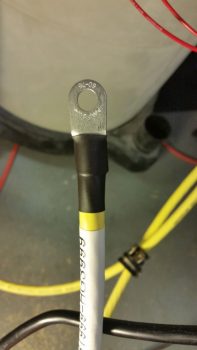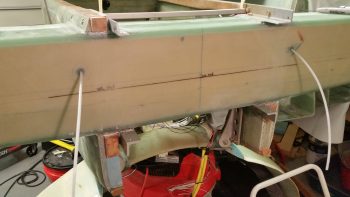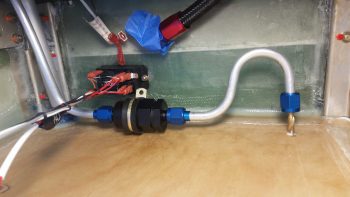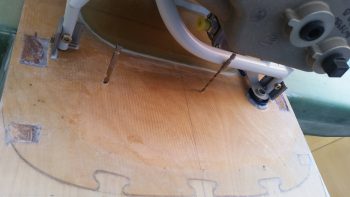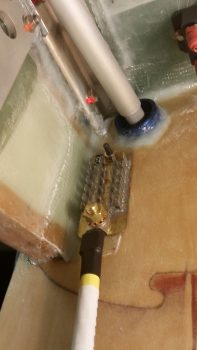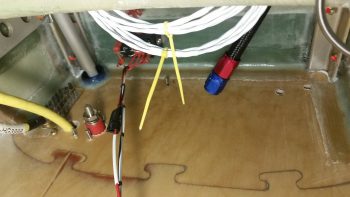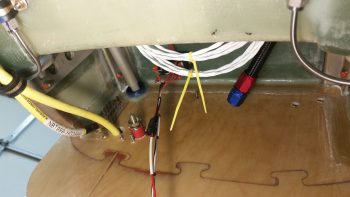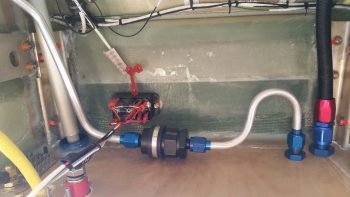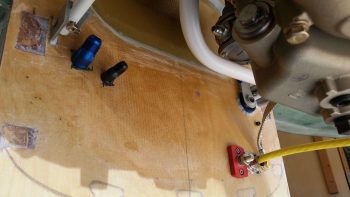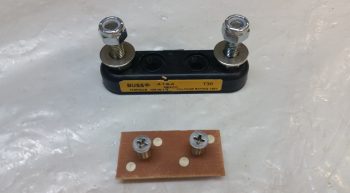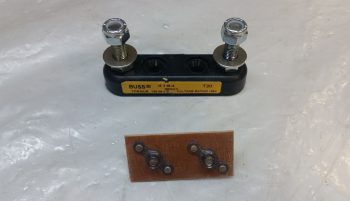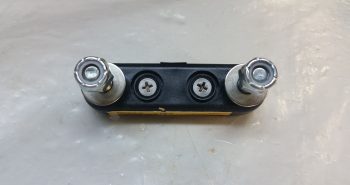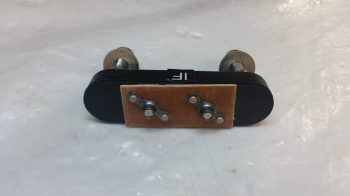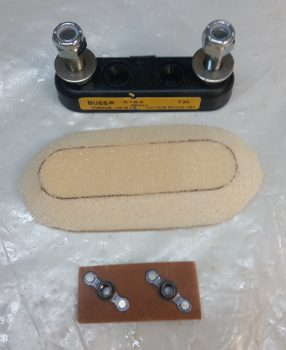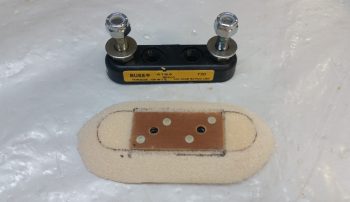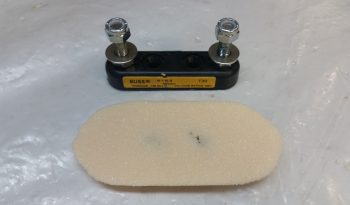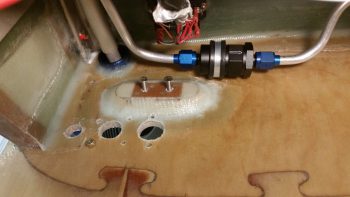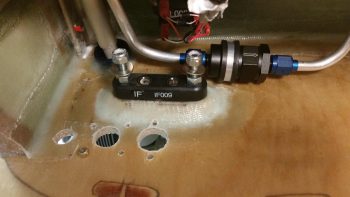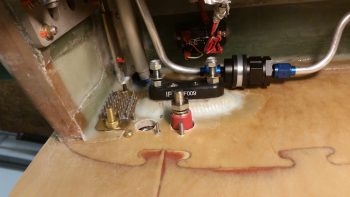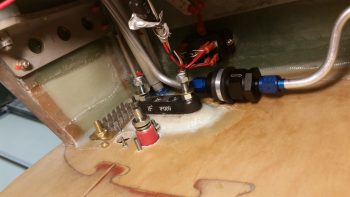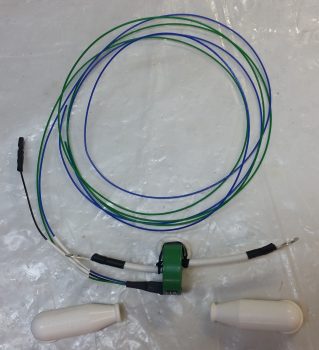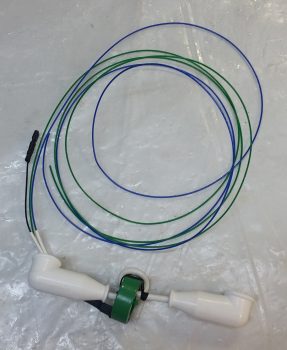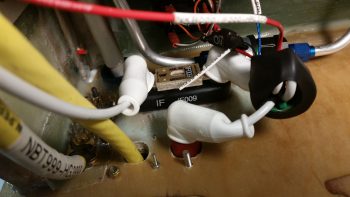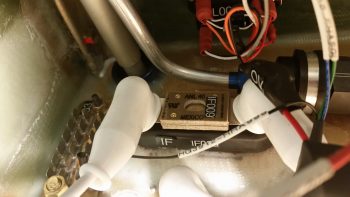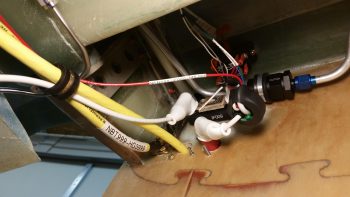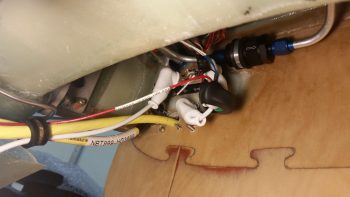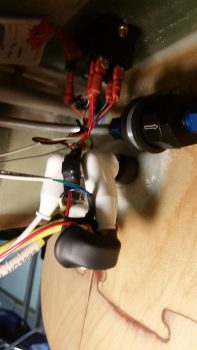Hell Hole Configuration
19 March 2018 — Part of the process (or at least my process) in prepping for installing the lower engine mount extrusions is to figure out where all the hell hole resident items go. I have a mount for the oil heat pump, and the laser altimeter for the nose gear’s new AEX system will reside on the bottom of the aircraft in the hell hole area, so the component most needing a home was the B&C SD-8 B/U Alternator relay.
My initial thought was to have it on the aft side of the GIB seat back, where I’d use a click bond stud on one side and a RivNut on the other. However, to do either I needed to open up the slots on each end of the relay to accept a #10 screw.
I used a 3/16″ drill bit first, then subsequently a 13/64″ drill bit, to open up & widen the slots on each end of the relay.
After poking, prodding, and probing around in the hell hole, I realized with all that was traversing through this busy area, and really wanting to keep components that can more easily get snagged away from the opening in the GIB seat (for cramming stuff into for much-needed storage during flights), I decided to place the SD-8 relay in pretty much the same spot that had once been ID’d for both the electric fuel pump and the GRT MAP sensor (both which have moved on to greener pastures): the bottom side of the CS spar.
I then taped up the bottom of the relay to protect it against any untoward glue-goobers, roughed up the face of each click bond (I can’t use a RivNut on the lower CS spar cap), then cleaned the click bond mating surfaces with Acetone…. making these babies ready for some 5 min glue!
Woah! As I was holding up the relay for a final location fit, I could visualize chunks of skin getting extracted from my forearm (accompanied by a stream of appropriate expletives) from the protruding click bond posts while I glassed in the lower engine mount extrusions. Since these click bonds can quite easily be glued/glassed in at a later time, I decided to table this exercise for a date AFTER the lower engine mount extrusions were installed.
For about 6 years now, ever since I skinned the outside of the fuselage, I have dealt with the pair of coiled-up 1/8″ aluminum brake lines in the hell hole. Well, I hit another major milestone today in that I finally –after all these years– trimmed those suckers down to a manageable length.
Again, in prep for the upcoming lower engine mount extrusions installation, I had to temporarily evict another hell hole resident: the FT60 Red Cube fuel flow transducer. If it was just the Red Cube I may have considered just taping it up, but with it’s pesky wire pigtail and the fact that it needs a good wipe down before final install, I yanked it.
I’ll of course cover up the remaining fuel line and FT60 mounting bracket with protective tape during the lower engine mount extrusions install.
•••
24 March 2018 — I started off today by removing the engine mount –which was a tight fit– exposing the 4 engine mounting extrusions.
here’s a closer look . . .
Using the taped up SD-8 relay and some 5-min glue, I mounted the 2 SD-8 relay Clickbonds on the underside of the CS Spar towards the right side a bit.
When I was making up my 3×5 card task list this morning, I also decided to verify my desired locations for the right and left brake line runs. I wanted them below the main gear so they were as accessible as possible via the bottom Hell Hell cover (disguising itself as an intake scoop) once the plane is completed.
I confirmed the positions and sanded down the areas that would get a few plies of BID to secure the Clickbonds into place. BTW, the Adels that are getting mounted to these Clickbonds won’t directly clamp to the brake lines, but rather will secure each side’s 3/16″ (from the wheel calipers) to 1/8″ (fuselage brake line run) Generant reducer fitting.
As the 5-min glue set, I then prepregged all the BID for laying up over the Clickbonds. Just before mixing up some epoxy with fast hardener, I wrapped each Clickbond threaded post with a small piece of electrical tape to protect against any epoxy gunk.
I then laid up 3 plies of BID over the SD-8 Relay’s Clickbonds and then peel plied it.
And did the same for the right & left side brake line Clickbonds.
Later I pulled the peel ply off all my cured Clickbond install layups… which all turned out pretty good. Here’s the SD-8 relay mounting Clickbonds on the underside of the CS Spar. BTW, I positioned these forward enough to be out of the way and not induce any added hassle when I layup the corner BID tape between the forward side of the firewall and the CS Spar
Here are the cured BID layups for the lower right (upper pic) and left brake line securing Clickbonds.
•••
26 March 2018 — I started off today assessing the configuration of all the hell hole components and the wires in, around and through the hell hole. I did some research on drilling into the CS Spar, knowing that the Spar Caps were sacrosanct, but what about the other areas? I’ll touch on this later in this post.
I then started my shop tasks today with a small repair. Yes, hard to believe that any of the 1/8″ aluminum brake line tubing coiled up in the hell hole since 2012 would ever get a ding or scrape on it . . . well, folks, the unthinkable happened! On my left brake line, about 6″ where it exits the lower fuselage, the tubing had a visible dent/crimp in it (circled in red in pic below).
My goal this morning was to either extricate the dent/crimp and repair the line –without destroying or mangling it– so that it would function as designed, or go with the nuclear option if need be: cut the line at this point and tie in the brake line coming from the wheel farther forward than I had planned.
By my calculations I was dealing with a 0.075″ diameter hole, and I measured a piece of hanger wire that I’d be using at 0.069″ …. Hmmm, seams like it should work (blue arrow in pic below). I filed the tip smooth and hit it with Acetone to clean it. But it proved just a tad too thick. Plus, it wasn’t as arrow straight as I would prefer.
After pondering a bit, Voila! I found the solution, pressing a perfectly straight and slightly narrower TIG welding rod into service. I marked a point on the rod that was past the offending dent in the line, and slowing worked the rod, and aluminum tube, to get the rod though the tube and remove the pinch in the line.
Here you can see I’ve reached my mark, denoting that the 1/16″ welding rod is clearly past the offending pinch in the brake line. I then worked the both the welding rod and tube for a good 10-15 min longer just to ensure that the dented section was as opened back up as close as possible to full diameter.
I wanted to institute some service loops for the brake lines and had some initial thoughts about using Adel clamps or some other means to keep the tubes in place. Not only did I want to keep the aluminum brake line tubes themselves clean in the event I may need to use them for any reason in the future, but I definitely wanted to protect them as well, especially since I do plan on jamming stuff into the hell hole for storage during flights.
I tried Nylaflow but the resulting loops against the lower aft side of the GIB seat back bulkhead proved too tight for Nylaflow. I even tried working the Nylaflow into a nice loop before placing it on the brake line, but it just kinked on me when the radius got too tight. Looking around the only thing I had on hand was the clear tubing I was using for the engine dehydrator, so I stole a couple of lengths off the line and pressed them into service.
Since the tubing will be out of the sun and under what we Canardians typically do in situations like this –bury it micro and throw a couple plies of BID on top!– I wasn’t overly concerned that it’s not “aircraft grade.”
After the protective clear tubing was in place over both brake lines, I then cleaned up the ends of aluminum tubing and temp mounted them in their respective reducer fittings. I then mounted the reducer fittings in their respective Adel clamps. That gave me a starting point to finalize the size and configuration of my brake service loops, which I then taped in place.
Here are Before & After pics of the right side brake line set in place and then with the service loop micro’d and glassed in place with 2-plies of BID . . . I used 2 plies to help protect the brake line against any untoward pinching. Obviously brakes are quite a useful thing in fast landing aircraft like Long-EZs.
And here are Before & After pics of the left side brake line set in place and then with the service loop micro’d and glassed in place.
A different view of the right side brake line with the service loop micro’d and glassed in place.
Left side brake line with the service loop micro’d and glassed in place.
I then set my sights on getting the wing NAV/Strobe and Wig-Wag lights wiring runs in the most unobtrusive, out-of-site way possible. As I mentioned at the start of this post, I had done a fair amount of research both in the plans, and online, in regards to drilling holes in the CS Spar. The results of my research was of course to stay away from the Spar Caps, no drilling through the shear web (which is actually common for the one hole required for the Autopilot roll servo, if used) and remain clear of the extrusion hard point areas.
I’m not sure exactly what #3 is all about since I have no plans on drilling INTO the hard points, but any viable hole for cable runs is going to be within 2″ of the hard points… and that is “in the area” in my book…. so of the 3 sacred “No-drill” rules I found, I’m apparently violating all the but the spar cap rule.
So, in probing around in my hell hole I discovered a spot up in each corner just aft of the CS Spar-GIB seat back intersection where there is sparse glass/flox. It’s actually the lower angled “bull nose” of the CS Spar and that is where I placed my bullseye for drilling a 1/4″ hole diagonally/aft on each side to run my wing lighting wires from hell hole to CS Spar (or vise versa). Here’s the result.
Might I say for my friends in the southern hemisphere: it worked a treat!
I then pulled the wiring out of the hell hole/CS Spar and took it upstairs for further processing (i.e. soldering). I then soldered the left and right CS Spar wing NAV/Strove light wiring together along with the shielded cable run to the light switch on the panel.
I know it’s fairly difficult to see the wires, but I looped them up over my kitchen light with both sides dangling down just to get an idea of how long the wiring harness is that we’re dealing with here. And this only gets out to the end of the CS Spar. The internal wiring that goes through the actual wings is yet to come!
Here’s the completed wiring harness for the wingtip NAV/Strobe lights. It’s late so I stopped on this harness, but I will also have wing tip (or outer wing let’s say) mounted landing/taxiing/wig-wag lights as well, which I still need to make up that harness for. BTW, the left/right CS Spar portion of the wiring is on the left in the pic below, the black ground wire will tie into the “Forest of Tabs” in the hell hole, and the wire bundle on the right goes forward to the switch on the instrument panel.
•••
27 March 2018 — I started off today finishing up the wing lights wiring harness #2 for the wings’ landing, taxi and Wig-Wag lights that will be mounted on the leading edge of the wing anywhere between the end of the wing and the outboard 1/3 of the wing…. with the goal to get them as outboard as possible.
This wiring harness actually involves a 20 AWG 2-wire shielded cable and then 2 external wire runs as well. On the shielded cable, I started by separating the internal wires and tying all the white wires, white/blue wires and the shield from the 3 separate cables: Left wing, Right wing and panel switch/power.
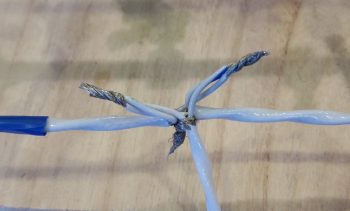 I then soldered spliced the bundled wires.
I then soldered spliced the bundled wires.
With the cables in a “T” configuration, it made it a bit challenging to heat shrink it all. So I did what I could on each leg, then used flight line tape around the center axis and secured that with some wire lace. Yes, Dr. Frankenstein would be proud, but it is secure!
Here’s the end result for the wings landing, taxi and Wig-Wag lights harness. Along the top is a blue (L) and green (R) wig-wag sync control cable, then the shielded 2-wire cable that provides separate power feeds for the taxi/landing light and the Wig-Wag functions. On the lower side you can see a black wire which is of course the ground wire. It shares a ground terminal with the shield ground lead from the 2-wire shielded cable.
I should point out that I had a good in-depth conversation today with AeroLEDs confirming my wiring scheme for all my wing lights, and they confirmed that I was installing them in the best configuration for a Long-EZ.
You may also note from the pic below that I spent a bit of time printing out wire labels and affixing them to the wires, both on this harness and on the Nav/Strobe lights harness I made last night.
I then grabbed my wiring harnesses and a handful of unattached wiring labels and headed to the shop. I ran the wing wires up through the holes from the hell hole side.
Once the wires were through the holes, I then attached labels for the wires running inside the CS Spar.
If you look closely, you can make out the wire channel that I drilled through the angled part of the front lower corner of the CS Spar.
Here’s a Hell Hole shot of the wing lights wiring harnesses from below.
And a taller shot of the wing lights wiring harnesses. The coiled up wires in the lower right of the pic will head forward to the respective light switches on the panel.
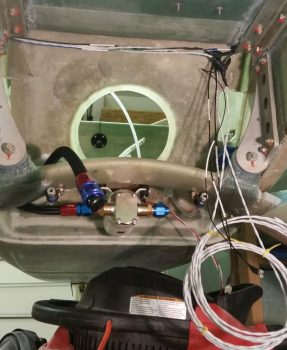 Admittedly, I have a fair bit of slack for the wires exiting out the ends of the CS Spar, especially on the right side. But better to have a little excess than not enough, eh?
Admittedly, I have a fair bit of slack for the wires exiting out the ends of the CS Spar, especially on the right side. But better to have a little excess than not enough, eh?
With the wing wiring harnesses in place in the hell hole/CS Spar, then came the questions regarding routing and securing. I wanted to ensure the wires were routed in an optimized fashion, to include accounting for the aileron control tube that transits through the Hell Hole.
After assessing and fiddling about with possible wire runs and securing options for a good 20 minutes, I finally decided on securing the wing light wiring harness “T” junctions with an Adel clamp set up high on the aft side of the GIB seat back bulkhead, well over to the right side. Although I had originally planned on keeping the “noisy” wing light wires as far from the “normal” wires as possible, I have accepted why this area has the moniker “the Hell Hole” as there is just not enough space to keep them all separated. What this means in practical terms is that the upper Adel clamp will secure pretty much all the wires entering/exiting the Hell Hole from the sides and above: both the special “noisy” wires and the “normal” wires.
I also added 2 plastic wire tiedown points in the middle and left on the upper seat back. If they look a bit low and askew, well… they are! When I installed them the wire bundle was higher up (read: in the way) and I placed a dab of 5-min glue in the center of each one. Well, as I was installing each one, the angle of the seat got the best of me and the original sticky backed pad on each tiedown point caught the seat just enough to pivot the tiedown forward and set it on permanently where it hit. Yes, this got me on both of the tiedown points… so they sit where they caught the seat! If I screw up, I like to do it twice to confirm that I screwed it up right!! (ha!) Luckily, they aren’t too low and will work fine. Thank goodness they’re in the Hell Hole… don’t tell anybody how crappy they look!
Besides the Clickbond that I bonded/glassed in place high on the seat back for a wire-routing/securing Adel clamp, I also added another RivNut hardpoint a few inches below and outboard (next to the seat access hole) for the same reason. You can see I floxed it in and taped it into place with gray duct tape.
I actually added a third hardpoint with yet another RivNut going straight down in the GIB seat back opening (it’s covered in black electrical tape). This Adel will essentially be the Gatekeeper for all the smaller wiring transiting into and out of the Hell Hole from the forward fuselage. With this setup what I’ve done is stay inline with Bob Nuckoll’s advice of keeping the big power wires separated from the little wires since this Adel sits a good 4-5″ above the big power wires coming from the battery compartment. Of course I will do all I can to maintain this separation the entire length of the fuselage.
I then got to work on the SD-8 B/U Alternator relay. My goal was to make the last connection point on the SD-8 a separate removable one for terminating the SD-8 voltage regulator power wire that comes in from the D-Deck/turtleback. My initial solution was to merely add knife splices to lengths of wires coming from both the voltage regulator and this relay, when an even simpler solution hit me: a double-tabbed PIDG FastON terminal. That would allow me to simply terminate the incoming voltage regulator wire to the relay with a standard FastOn terminal.
All this is taking place at the furthest right corner of the relay in the pic below, where the bare FastOn tab is visible on the edge of the relay. Again, this is where the power wire from the SD-8’s D-Deck located voltage regulator will get connected to the relay.
I then prepped the relay wire bundle by securing the Over Voltage module and wire lacing the initial wire runs coming from the relay.
Here’s a closer look at the wire lacing on the SD-8 B/U alternator relay wiring harness.
•••
28 March 2018 — Today’s build efforts were marked by a lot of trial & error test fits, measuring and mock-ups in an effort to get all the Hell Hole components integrated and playing nicely together in a rather small area. If you’ve ever seen the TV show, Monk, you can get sense of my emulating Tony Shalhoub “feeling” a crime scene in my efforts to figure out placing components in the Hell Hole. Ha!
My first required piece of information before I started mixing epoxy was to figure out how I was going to route the big power cables coming from the nose: either above or below the main gear bow. My initial thought was above the gear bow but I just couldn’t get the bend right on the big power cables to miss the sharp edge on the forward gear mount extrusion.
My test run of the big power cables below the gear bow proved much more successful in regards to not having any sharks’ teeth in the way of hard edges at the ready to gnaw through one of these big (which means important! right?!) cables.
Moreover, having to remove and install the big power cables in an Adel clamp in the access hole at the base of the GIB seat bulkhead exposed yet another potential gnawing issue on the rather sharp outboard access hole edge. Thus, I spent a good 20 min with some Perm-A-Grit tools and my mini German hack saw to create a nice round cable-shaped edge in the corner to alleviate any future pain & suffering to my outboard positioned big yellow cable.
I also test routed the return line for my oil heat system a half dozen times to get the right position for the Adel clamp Clickbond hard point. Not only does the Adel clamp secure the oil return line, but it will keep it pressed downward a hair to also avoid the left front mounting extrusion of the main gear.
With my Adel clamp positions –and thus my Clickbond hardpoint positions– known, I pressed forward with setting them in place with 5 min glue. Below is the left side oil heat return line Clickbond on the left aft side of the GIB seat bulkhead.
I then glassed it with a 2″ x 2″ 3-ply BID pad….. peel plying it of course.
Here we have the oddly positioned Adel clamp Clickbond hardpoint for the 2 big power cables. I placed it on the corner like that to best angle the cables so that they are positioned well for mounting to or traversing through the firewall. In addition, I wanted to minimize the added depth directly below the gear bow here to just the thickness of the cables, and not add the thickness of a bulky Adel clamp.
I cheat a bit when it comes to glassing on the gear pads or gear bow and add an extra ply or two, as well as making them oversized, just to take the opportunity to add a bit more oomph to main gear strength. Here is a 4-ply BID pad for the Clickbond that covers about 3/4 of the existing gear mount pad.
With the leftover epoxy I whipped up some thick micro and filled in some open blemishes on my brake line loops… and then peel plied the micro.
I still had just a bit of epoxy left over (I always seem to make a bit too much when I just get back into glassing after a long hiatus) so I glassed in a 2-ply BID pad that I had planned to put in around the final wire access hole that I’ll drill into the inside floor of the CS Spar.
Here’s the 2-ply BID pad after I removed the peel ply a couple hours later. Tomorrow I’ll glass a 2-ply BID pad on the underside of the CS Spar in the same area. When the hole gets drilled I will be digging out the surrounding foam and creating a flox hardpoint around the hole to reinforce any strength that may be lost in creating the hole.
With my shop work done for the evening I headed upstairs to do the final -6 45° AN fitting install on the FT-60 “Red Cube” Fuel Flow Transducer. I wanted the fitting clocked more aligned to the side marked with “FF” but it was just too loose in that position. I checked to see if I had any more -6 45° AN fittings on hand, but I didn’t. So, I took it down to the Hell Hole and checked to ensure there was enough clearance with the fitting situated as it is more up than slanted straight inboard. The clearance is fine –I’m using a 45° fitting to more easily clear the aft main gear mount– but it will mandate that I get a little more creative with my bends on the 3/8″ aluminum fuel line run to the filter. (I also constructed 2 of the 3 connecting wires for the fuel flow meter).
Also pictured is the brass fitting that I picked up from Airflow Performance when I ordered my Sniffle Valve. It looked as if it had a lower profile than the 90° barbed brass fitting that I had on hand for the mechanical fuel pump overboard vent port. In comparing the two fittings, this one looks like it will be a bit more shy and protrude out about 0.15″ less than the barbed brass fitting. Yes, not much, but when we’re talking engine to firewall clearance, every bit helps. Since I had the Loctite 567 out, I went ahead and installed an aluminum barbed fitting into the right angled brass fitting.
Lastly, I figured I would provide a glimpse inside my “evil lair” at what I call poor man’s CAD: paper, pencil, ruler and an eraser!
My final act of the evening was to update the external aircraft lights electrical diagram.
•••
29 March 2018 — I started out today by drilling a hole inside the CS Spar floor down at an angle from outboard to inboard so that the wiring coming up from the Hell Hole would better follow the contour of the side of the oval opening in the CS Spar. My goal is to have the wires accessible and situated just inside the CS Spar oval opening.
I drilled only through the top layer of glass and then spent almost a half hour digging out as much foam as I could get to, which if you look at the circular empty cavity next to the hole as visible due to a light placed below, it’s roughly the same size as the AN970-4 washer next to it. That’s quite a solid hardpoint considering this foam is 1″ thick [As a point of note I used Divinycell for the spar vs the Urethane called out for in the plans… so slightly heavier spar, but inherently stronger].
I filled this cavity up with about a 60/40 mix of flocro, slightly heavier on the flox, and let it cure before drilling out the hole all the way. In addition, I concurrently laid up a 2-ply BID pad measuring 2″ x 4″ on the underside surface of the CS Spar in the Hell Hole that encircles this hole (I didn’t get a pic of that layup…)
While the stuff above cured, I then pulled the wing lights’ wiring harness back out to wire lace the wires. Once finished I reran the wiring harness through the CS Spar.
I stopped the wire lacing just shy of each end of the CS Spar (cable lace shown by red arrow).
Here’s the right side wing wiring harness cable laced, draped over the left fuselage side.
I then cable laced the wing wiring inside the Hell Hole and secured it to the seat back via my plastic wire tie-down points. The loose wire at the top apparently got away from me and at the angle I was working at I simply didn’t see it until I looked at this pic! No worries, I’ll simple secure it as well. I will say that where that loose wire is located is where I was aiming to put the wire tie-down points before the seat “reached out” and grabbed them! Still, the setup works fine and all the wires are nice and secure.
I then test fitted the big power wire runs through the Adel clamp on the bottom side of the gear leg pad. This configuration works really well in keeping the wires from possibly getting pinched or damaged.
I really like this configuration as it looks like it will work really well in keeping the wires from getting gnawed through from any vibration…
especially at the transition from Hell Hole into the cockpit via the access hole in the GIB seat bulkhead.
I then did the final install on the FT-60 Red Cube fuel flow transducer. After torquing both AN4 mounting bolts and the -6 tubing AN fitting nut, I applied orange torque seal to the -6 AN fitting. In hindsight I should have applied torque seal to the AN4 bolt heads as well, so I noted that needs to be done.
Here’s a shot of the final mechanical install of the FT-60 Red Cube fuel flow transducer.
I then added cable management Adel clamp #2 to run the 3-wire cable from the Red Cube fuel flow meter upwards. Again, I situated the Adel cable management clamps in their locations to not only keep all the wiring wrangled, but specifically to keep the wires off the aileron torque tube that traverses this part of the Hell Hole.
I then ran the 6-wire cable from the Instrument Panel along the fuselage sidewall, through the wire routing Adel clamps in the Hell Hole and up through the lower wire access hole in the CS Spar.
This 6-wire cable contains wires that interface between the EIS4000 in the D-Deck and panel avionics. Here the 6-wire cable is heading up towards the D-Deck/GIB headrest. Note that this hole will serve as the sole remaining access hole on the lower CS spar plate for all wires heading to & from the D-Deck/GIB headrest-based components.
I also did a final install on the oil heat return line Adel clamp.
I then spent well over 2 hours shaping, cutting and installing the 3/16″ stainless steel brake line tubing that runs through the plastic tubing channel that I glassed into the gear fairing, situated on the TE of the original gear bow.
Shaping the right side brake line was a little trickier because I had to go up, over and around the big yellow power cables. I had considered looping aft and below the cables, but I wanted as little brake line as possible hanging out unsecured in free space. So I went up and over the big yellow cables. I spent well over 2/3rds of my time working these brake lines on this right one.
The left was significantly easier, although bending stainless steel is not the easiest, daintiest of endeavors to undertake –especially when small bends or curves are required on a small length of tubing. But through persistence I finally got both stainless steel brake lines routed through the gear legs and installed in the 3/16″ to 1/8″ Bi-Lock reducers (thanks to Dave B. for the gouge on those!).
All that is left now (although not a significantly EZ task) is to cut these lines near the wheels and cross connect them to the 9.25″ long -3 stainless steel hoses that are the final link in the brake line chain.
I then did the final install on the oil heat pump on the bottom centerline of the aircraft. I like this pic below because it shows the oil heat pump, finished right brake line and secured big yellow power cables.
I had to spend a bit of time cleaning cured epoxy off the ends 2 of the 4 bolts hanging down from the oil heat pump, but after that I was able to bolt the pump in place EZ-PZ.
•••
30 March 2018 — I started off finalizing the install of the remaining Hell Hole components before installing the firewall.
The first order of business was shaping the last bit of 3/8″ aluminum tubing for this airplane to finish up the fuel lines from tanks to firewall. I had to shape and terminate 2 lengths of tubing with AN -6 fittings on each end.
I started on the backwards question mark looking piece that is the final run of tubing before getting attached to the firewall pass-thru fitting. I try to avoid right angles on my fuel lines (not that it would matter that much here, honestly… I just didn’t have any fittings on hand) so I made this swooping loop with shallow right angle curves. With this done, it would determine the length of tubing required for my cross connect between the FT-60 Red Cube fuel flow meter and the 30 micron filter (required by Silver Hawk fuel injection system).
The tube cutting, bending and flaring process went without event, and I must be getting decent at this stuff because these two lines are the only ones I made: as in no extra pieces of mangled tubing scattered on the floor . . . not that I haven’t done that before!
In the first piece below, you can see a black dot on the wood cross piece I clamped in place to simulate the inside surface of the firewall. This dot was my target end point for the tubing and for placing the fuel line firewall pass-thru fitting. I was fairly close on my final configuration. BTW, as you probably surmised, the wood cross piece is to simulate the firewall not only for guesstimating the fuel line exit point, but also to ascertain the depth required to give me the proper tube length between FT-60 and filter so that the fuel filter Adel clamp would be positioned up against the forward side of the firewall for mounting.
With the fuel line and filter in place, I then verified that the SD-8 relay and fuel filter could coexist in the same area . . . which they can quite comfortably.
Speaking of the SD-8 B/U Alternator relay, as you can see I permanently mounted it in place under the CS Spar. After I took this pic (and video) I then taped it up to protect it from any errant epoxy when I mounted the firewall in place with BID tapes just aft of the relay.
Since it was a quick kill, I terminated the big yellow ground cable with a ring terminal for eventual connection to the big brass bolt that goes through the firewall…. with the engine ground strap attached on the hot side of the firewall and the forest of tabs on the cold side. [I can’t do this with the starter power lead since it will need to get run through the small stainless steel firewall fitting first before it gets terminated].
I slipped on an appropriate label and hit it with the heat gun, then a short length of black heat shrink to cover the crimp. Then I clamped this baby up tight in the vice!
I then finished off the crimp with some heat shrink.
And Voila! The final terminated big yellow ground cable that gets bolted to the forest of tabs post inside the Hell Hole.
Then, to cover all my recent lower engine mount extrusions, engine mount, Hell Hole wiring and components installs, I made up a short (kinda) video to provide an overview of what I’ve been up to.
I then snapped a couple final official shots of my bird sans permanently mounted firewall….
•••
12 April 2018 — Today was all about getting as much of a jump as possible on the firewall configuration to get that stuff knocked out early.
After reviewing some info on installing NPT fittings I felt I should do my due diligence and check the torque on the 45° AN6 fitting exiting the FT-60 Red Cube fuel flow meter. It was tight, but I thought it could be tighter. However, if you’ve seen the install manual there is explicit warnings not to over tighten a fitting on account the transducer’s case might actually crack. In the AFP-30 Air Data Computer install manual there’s some literature on the FT-60 that states to torque the fittings to 25 ft-lbs. Since I had a box wrench adapter on a short extension mounted to my torque wrench, I dialed the torque down to 23.5 ft-lbs to ensure I didn’t crack the FT-60 case. Surprisingly, I was able to get one more entire revolution out of the 45° AN6 fitting… with how much pressure I had to exert to get to that 23.5 ft-lbs (again, remember I was using an protruding box wrench adapter on a short extension… both serving to add a mechanical torque advantage), I’m surprised people go further than that to crack these darn things!
Once I got the aft fitting on the FT-60 squared away, I then did some minor tweaking of the fuel filter and lines to get the filter flat again the front face of the firewall. I then marked the position of the Adel clamp hole and the fuel line exit point on the firewall. From inside the hell hole I drilled small holes out using my right angle drill. I then drilled from the aft firewall side coming back into the hell hole. You can see the drill bit in the pic below peaking through the firewall and aligned with the fuel line fitting.
Here’s a shot from the firewall side of my initial 2 holes through the firewall for mounting hell hole and firewall assemblies and pass-thrus.
I then took a #10 screw and Dremelled the head of it to create indentions for flox to better grip it.
On the hell hole side of the forest of tabs, I then installed the big yellow ground cable that runs the length of the firewall to the negative ground post on the battery.
Here’s the hell hole view of all my firewall-based shenanigans. Note that the fuel filter mounting screw is visible in-between the 2 yellow zip ties.
Here’s a little broader view specifically showing the Adel clamp that secures the pair of big yellow power cables.
•••
13 April 2018 — I started off this morning inventorying a much-needed order from ACS that I just received. Included in the order was -20 sized Adel clamp for the fuel filter, that I immediately pressed into service. I cleaned the fuel lines fore and aft of the fuel filter then mounted them “permanently” (albeit servicing will occur…yes) to the filter, as well as permanently mounted the origin of the incoming line of the fuel filter (on left in pic below) at the FT-60 Red Cube fuel flow transducer.
I also received the 45° -6 AN bulkhead pass-thru for the fuel line and a 45° -8 AN bulkhead pass-thru for the oil heat return line. I finished drilling out those pass-thru holes to size and mounted the fittings through the firewall. As you can see I then mounted the fuel line and the oil heat return line to the 2 new firewall pass-thru fittings. To be clear, these pass-thru connections are NOT permanent installs at this point since they’ll need to be removed when the Fiberfrax and 6061 aluminum sheet cover get mounted to the firewall face.
Here’s a firewall shot of the 45° -8 AN pass-thru for the oil heat return line and the 45° -6 AN fuel line bulkhead pass-thru.
•••
19 April 2018 — My 2 goals for the day were to install both the ANL40 base, fuse link, etc. and the GRT EIS Hall Effect sensor on the front face of the firewall in the hell hole.
I started by ginning up a phenolic nutplate assembly with the same #10 screw pattern as the ANL40 base. Since the fuse link sits in the middle of the 2 posts on the base, the only screws that can be used are countersunk screws. Since I was mounting the unit on the front face of the firewall I clearly could’t put nutplates on the aft firewall face, so I had to go with a in-Hell Hole surface mount solution.
Here’s the aft side of the ANL40 nutplate assembly.
And a couple shots of the nutplate assembly installed on the ANL40 mounting base.
To embed the nutplate assembly onto the forward firewall surface in the Hell Hole, I made a mounting pad for the ANL40 mounting base from 3/8″ PVC foam.
I then carefully carved out a notch for the nutplate assembly in the foam mounting pad.
Here’s a bottom shot of the foam mounting pad with the nutplate assembly installed.
I then used 3 plies of glass (BID/UNI/BID), prepregged, and glassed the ANL40 foam mounting pad with the nutplate assembly flocro’d into place (with all the typical pre-work: micro-ing foam, etc.). Again, the mounting pad was glassed onto the forward side of the firewall in the hell hole.
A few hours later I cleaned up the cured layup (yes, I used fast hardener) and test installed the 2 ANL40 base mounting screws. I also trimmed the glass overhanging the existing firewall electrical package component holes and redrilled the upper holes for the mounting screws.
I then mounted the ANL40 base into place with the 2 countersunk screws.
And remounted all the firewall electrical package components (again, except for the ANL40, these are all temp mounts until the Fiberfrax and 6061 aluminum firewall cover are in place). I uploaded both pics of this since they show a bit different viewing angles.
Being able to get a feel for the space between the Blue Sea B-Lead connector (it’s red) and the ANL40 base, I then got to work finalizing the GRT EIS Hall Effect sensor configuration. I trimmed the long 8 AWG wire and terminated the Blue Sea connector end with a 3/8″ terminal. I also labeled & trimmed the ground wire, then terminated it with a Fast-ON PIDG terminal.
I slipped on the white rubber boots, and Voila! Ready for install.
I then installed the ANL40 fuse link into its base, on top of the glassed-in foam mounting pad (with the embedded nutplate assembly) and then got busy connecting all the cables to their appropriate mounting lugs.
I also co-ran the red 14 AWG SD-8 backup Alternator power feed wire through the GRT EIS Hall Affect sensor a couple of passes (both the primary alternator B-Lead and the SD-8 backup power feed get passed through the Hall Effect sensor twice to place the readout scale on a 0-50 Amp scale vs a 0-100 Amp scale… the latter which I don’t need since my primary alternator only puts out 40 Amps max).
The route of the electrons is this: Alternator current runs via B-Lead to the firewall side of the Blue Sea pass-thru connector (red fitting), then on the inside of the Blue Sea pass-thru a cable runs to the right post (in pic below) of the ANL40 fuse link VIA 2 passes through the Hall Effect sensor donut. Then, from the ANL40 left post (again, as depicted in pic below) an 8 AWG B-Lead cable carries the current up to the nose, connecting to the Master Battery Contactor (as depicted in my updated diagram way up there ↑).
Here’s a closer up shot of the installed ANL40 Fuse Link.
In addition, you can also note that I used a decent sized piece of heat shrink to seal and cinch up all the wiring going through and wrapped around the Hall Effect sensor donut. It may seem like the Hall Effect sensor is left to sway to-and-fro in the wind, but with the robust 8 AWG cable securing it in place, and the amount of force I had to apply to get both terminal ends in place (not excessive, but it’s tight) …. that puppy ain’t budging!
Another angled shot of the ANL40 fuse link for the alternator’s B-Lead feed and the GRT EIS Hall Effect sensor . . . plus note the additional “big” wire runs that are deemed big enough to hang out and traverse the fuselage with the big yellow cables.
And a final parting shot for the evening.
•••

